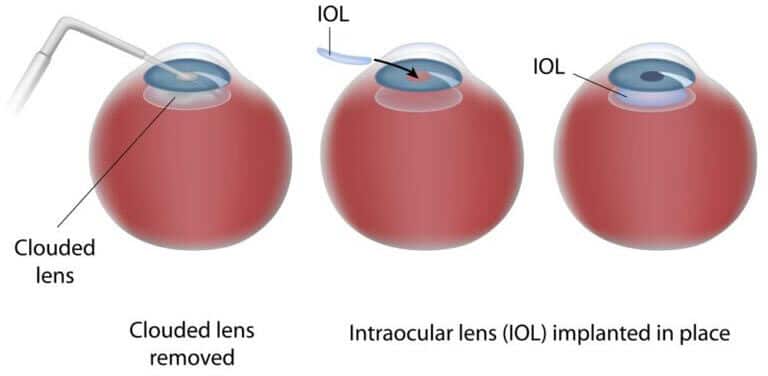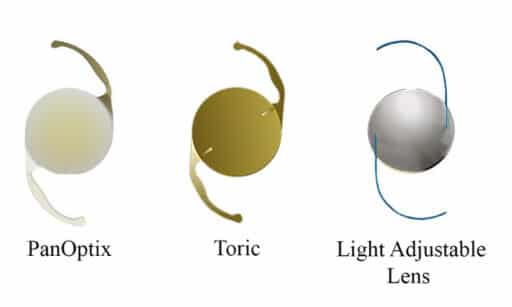Home » Cataracts
Cataracts
Cataracts Treatment in Syracuse, NY
A cataract is clouding of the eye’s natural focusing lens. Frequent changes in glasses prescription can be a sign of early changes in the lens of the eye. When a cataract begins, the vision can appear as looking through a foggy window or a piece of wax paper like the picture on the right.
Find out if you’re a candidate for cataract surgery:
Cataract development is usually a very gradual process of normal aging, but can often occur rapidly. Many people are unaware of cataract development as changes in vision can often be very gradual. Cataracts are very common, affecting roughly 60% of people over the age of 60, and over 1.5 million cataract surgeries are performed in the United States each year.
Cataracts can also be hereditary, occur as the result of a medical condition or medication use.
What Symptoms Are Associated With Cataracts?
Cataract Surgery in Liverpool, NY
Cataract surgery is a very successful operation. It is one of the most common operations performed in the United States; approximately one and a half million people have this procedure every year. As with any surgical procedure, complications can occur during or after surgery and some are severe enough to limit vision. There are two basic steps in cataract surgery: cataract removal, and lens insertion.
Cataract Removal
Modern cataract surgery has been developed and refined for over a century. Phacoemulsification is the standard technique used today. It was developed in the 1970s by Dr. Charles Kellman at Wills Eye Hospital in Philadelphia and uses ultrasound to fragment the cataract into smaller segments. This allows for the cataract to be removed safely from the eye through a smaller incision. Dr. Cecchi uses a 2.4 millimeter opening in the eye to perform all parts of the surgery.
Lens Replacement
Once the cataract is removed, an artificial intraocular lens, or IOL, is placed within the eye. The eye’s natural structures act like an envelope to hold the new lens in place. When the cataract is removed, the transparent cataract membrane is preserved within the eye to act as a housing for the new lens.
Most intraocular lenses today are made of acrylic and are inert within the eye. Other materials that have been used in the past include silicone and poly-methyl-methacrylate (PMMA or plex-glass) and are not as commonly used. The acrylic material is easily foldable, which allows it to be passed through the small cataract incision. It is then able to unfold to its natural resting place within the eye.
The new lens has focusing power. Without this lens, the eye as an optical system does not work well and would require extremely thick glasses to improve vision. A standard lens is able to focus the eyesight for distance vision, and in many cases, can achieve excellent results without the need for glasses at a distance.
Lens Choices
There are 4 essential lens choices.
Monofocal IOL, Multifocal IOL, Toric IOL, and Light Adjustable IOL or LAL.
Monofocal IOL
Monofocal IOL with focus the incoming light onto the retina. Monofocal, as the name suggests, will focus on one target only. Usually, this IOL focuses the eye for best distance. In this case, glasses are needed for near vision.
Multifocal IOL
Multifocal IOL employs technology within the new lens to allow the eye focus at multiple points without the use of glasses. This IOL requires the health of the eye to be excellent for proper function.
Toric IOL
Toric IOL is used when significant amount of astigmatism is present. Astigmatism is a condition of the eye’s surface independent of cataract. Once the cataract is removed, if astigmatism is present, a significant amount of distortion form the corneal surface can cause blurry vision after surgery which would require glasses to correct. Monofocal IOL and Multifocal IOL are both available with astigmatism correction.
Light Adjustable Lens (LAL)
Light-Adjustable Lens (LAL) is new technology which allows for adjustment of focus after surgery. This Ultraviolet sensitive lens material can be modified to make changes to the focal point of the new lens. This can be done to refine the original desired focus more sharply or change the intended focus, either for distance or reading.
Before cataract surgery, Dr. Cecchi will prescribe medications to be used prior to the day of surgery to aid in safe and effective procedure. On the day of surgery, the eye must be properly cleaned and dilated. The pre-operative nurse applies dilation drops and cleanses the eye surface and will also place an IV. An anesthesiologist meets with you to go over any pertinent medical issues and to describe the sedation you will receive. Dr. Cecchi will also briefly meet you prior to the procedure.
A topical anesthetic is used before the procedure begins and the anesthesiologist will also provide sedation through the IV. Sterile technique is used throughout the procedure to ensure a safe and comfortable process. The surgery itself usually takes about 10 minutes to complete and most patients are completely comfortable throughout the process.
Recovering from cataract surgery is fast and relatively easy. Most patients will notice improved vision with their new lens within the first 24 hours. It is important that you follow the postoperative instructions provided by Dr. Cecchi.
Restrictions After Surgery
For one week: No strenuous physical activity, including but not limited to Heavy weightlifting, chiropractic manipulation, heavy manual labor. No prolonged head down position or bending at the waist, such as inversion yoga. No contact with dirty environments such as dental cleaning, contact with pools, hot tubs, or working in barns. WEAR THE HARD SHIELD PROVIDED IN THE BAG PROVIDED.
You may: Engage in light aerobic activity such as walks, light treadmill or cycling. Shower as usual without allowing water or shampoo to stream into or around the eye. This is generally recommended with your back to the water without allowing the stream to make direct contact with the eye or face.
Think you may be a good candidate for cataract surgery? Contact our offices located in the Oneida, Liverpool, and greater Syracuse, NY areas today!
To learn more about each IOL, and find out which one is best for you, take our IOL Self-Test.











